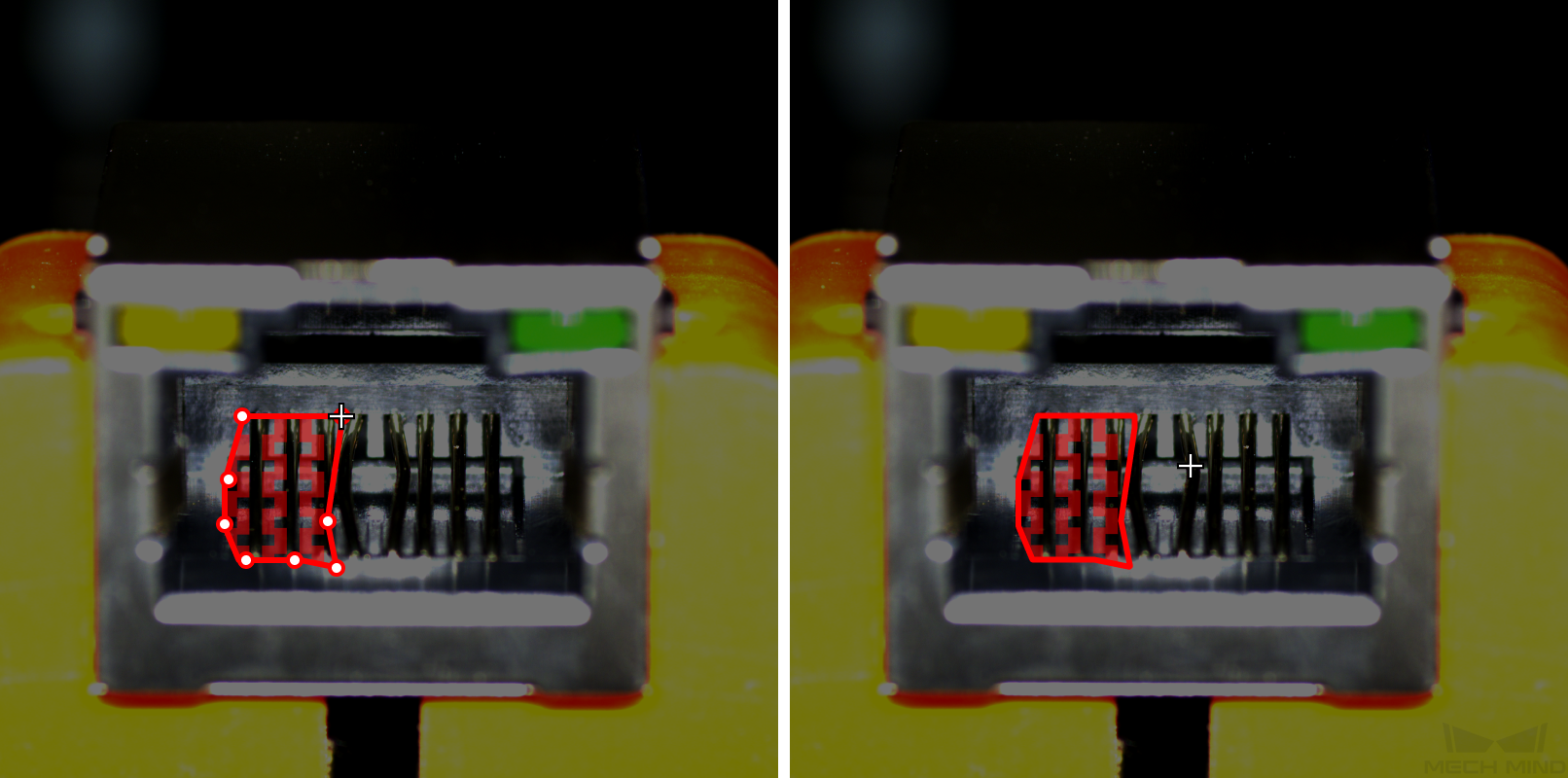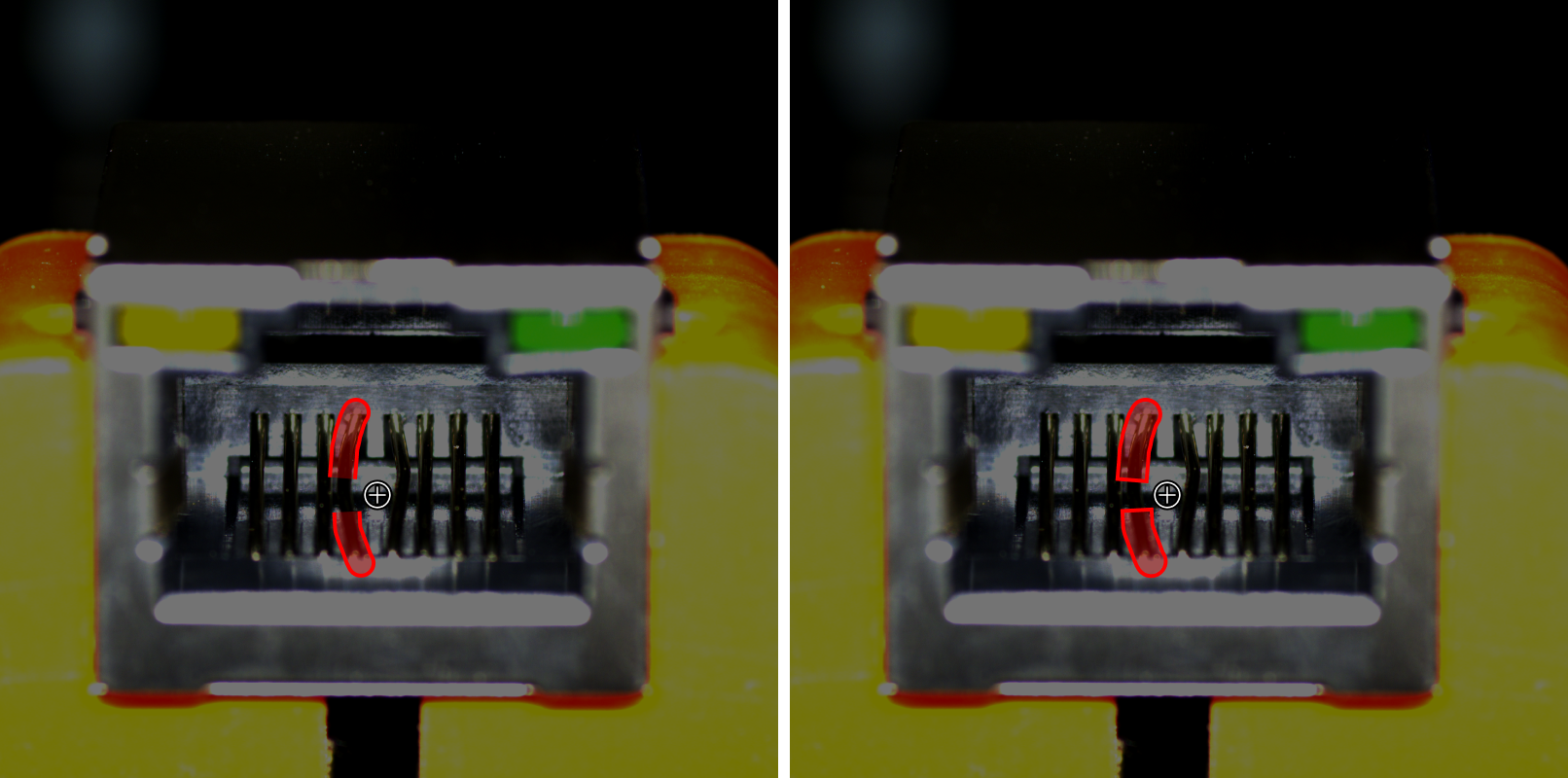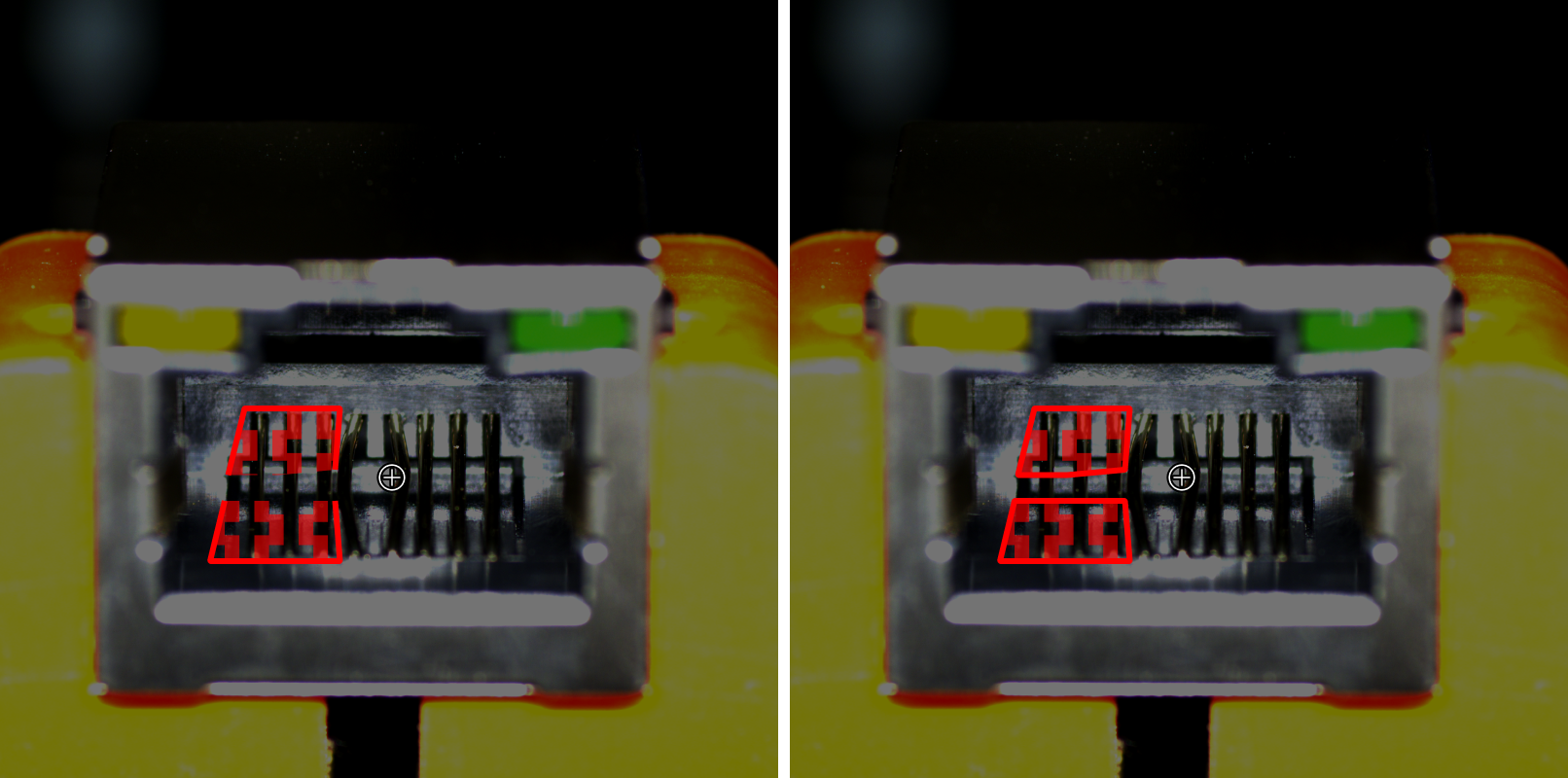Introduction to Labeling Tools
OK Label
Use the OK Label ![]() to label an image as OK.
to label an image as OK.
-
Select an image from the image list and then click the OK Label on the toolbar. The image will be labeled as OK.
Defect Labeling Tools
Defect labeling tools can label the defects in images to provide the information required by deep learning training.
You can choose among the following labeling tools built in the software according to actual needs.
Polygon Tool
The Polygon Tool can draw polygon labels with more vertices, which is suitable for regular defects.

-
Click
 (or press P on the keyboard).
(or press P on the keyboard). -
Click the first position (vertex) in the selection area, then click the second one, third one, etc., to draw the labels, and right-click to finish.
Brush Tool
Use the Brush Tool to draw labels of any shape. This tool is suitable for defects with complex shapes.

-
Right-click
 and then click
and then click  (or press B on the keyboard).
(or press B on the keyboard). -
Adjust the slider to set the thickness of lines according to the size of defects.
-
Long press the left mouse button in the selection area, move in any direction, and then release the left mouse button to finish the drawing.
Autofill Lasso Tool
Draw arbitrarily shaped labels by forming closed shapes with brush paths. This tool is used for defects with complex shapes.

-
Right-click
 and then click
and then click  (or press A on the keyboard).
(or press A on the keyboard). -
Long press the left mouse button in the selection area and move in any direction.
Smart Labeling Tool
The Smart Labeling Tool can be used to automatically select the objects in the image. When multiple objects in an image have large color differences and are scattered, you can use the Smart Labeling Tool to conveniently label the objects in the image.
Currently, the Smart Labeling Tool can work in two modes, and it will automatically switch between them according to the actual situation. Users do not need to manually select a mode.
-
Standard mode (GPU): In this mode, the Smart Labeling Tool has robust labeling capabilities. This tool will automatically switch to the standard mode if the running device has a GPU, with available GPU memory of at least 2.5 GB, and there is no project undergoing training or validation.
-
Lite mode (CPU): In this mode, the Smart Labeling Tool has basic labeling capabilities. This tool will automatically switch to the lite mode if the running device has no GPU, or the available GPU memory is less than 2.5 GB, or there is a project undergoing training or validation.
Steps
-
Click
 (or press A on the keyboard).
(or press A on the keyboard). -
Move the cursor in the selection region and then click the object to be labeled.
-
If the selection cannot completely cover the object, click the uncovered part to expand the selection area.
-
If the selection covers the areas outside the object, right-click these areas to reduce the selection area.
-
-
Click Apply in the upper-left corner of the selection region.
You can use the Select Tool to fine-tune the labeled contour by the following steps:
-
Use the Select Tool to select the label to be adjusted.
-
Adjust the contour in one of the following three ways according to actual situation. Please ensure that the selected area closely aligns with the object contour.
-
Place the mouse cursor on a vertex of the contour. When the cursor turns into
 , long-press the left mouse button and drag the vertex to adjust the contour.
, long-press the left mouse button and drag the vertex to adjust the contour. -
Place the mouse cursor on a vertex of the contour. When the cursor turns into
 , click the right mouse button to delete the vertex.
, click the right mouse button to delete the vertex. -
Place the mouse cursor on the contour. When the cursor turns into
 , click the left mouse button to add a vertex.
, click the left mouse button to add a vertex.
-
|
When the objects differ greatly in colors and have clear contours, it is recommended that you label multiple objects at a time and click Apply. If the objects are not obviously distinct, it is recommended to label one at a time. |
Pre-trained Labeling Tool
After you validate a model, you can import new image data to the current module and use the pre-trained labeling feature to perform auto-labeling based on this model.
| The pre-trained labeling feature is available only when the current module contains validated models. |
The Pre-trained Labeling Tool can be used only on the following two types of data:
-
Unlabeled data
-
Automatically labeled data (images with a yellow triangle at the front of the image number)
|
|
The pre-trained labeling feature can outstandingly reduce the cost of manual labeling. However, the accuracy of the results depends on the model that you use. We recommend that you train a high precision model before you use the pre-trained labeling feature. |
You can use the Pre-trained Labeling Tool in one of the following three methods.
-
Method 1: Pre-trained labeling button
-
On the upper part of the image list, click the Pre-trained labeling button. All images in the image list will be labeled by using the Pre-trained Labeling Tool.
-
After the labeling process is finished, you can view a yellow triangle in the upper left corner of the sequence number of the labeled images.
-
-
Method 2: Pre-trained labeling option
-
In the image list, select one or more images that you need to label.
-
Right-click the images and select Pre-trained labeling, the labeling process starts. After the labeling process is finished, you can view a yellow triangle in the upper left corner of the sequence number of the labeled images.
-
-
Method 3: Pre-trained Labeling Tool
-
In the labeling toolbar, right-click
 , then click
, then click  (or press D on the keyboard) to select the Pre-trained Labeling Tool.
(or press D on the keyboard) to select the Pre-trained Labeling Tool. -
On the upper part of the image, click Start labeling, and the Pre-trained Labeling Tool will start to label the image. After the labeling process is finished, you can view a yellow triangle in the upper left corner of the sequence number of the image.
-
|
Mask Tool
If there are some irrelevant parts that may interfere with model training/inference, you can use the Mask Tool to cover such parts. The masked parts will not be involved in training/inference. For example, the object surface features that should not be judged as defects but are similar to defects, need to be masked out.
You can choose among the following three mask tools built in the software according to actual needs.
|
Mask Polygon Tool

-
Click
 (or press Shift + P on the keyboard)
(or press Shift + P on the keyboard) -
Set Mode and Fill.
-
Click the first position (vertex) in the selection area, then click the second one, third one, etc., to draw the labels, and right-click to finish.
Labeling Eraser Tool
The Labeling Eraser Tool can be used to erase the labeled region.

-
Click
 (or press E on the keyboard)
(or press E on the keyboard) -
Long press the left mouse button in the selection area and move in any direction.
Adjust the slider to change the eraser size.
Mask Eraser Tool
The Mask Eraser Tool can be used to erase the masks.

-
Right-click
 and then click
and then click  (or press Shift + E on the keyboard)
(or press Shift + E on the keyboard) -
Long press the left mouse button in the selection area and move in any direction.
Adjust the slider to change the eraser size.
Grid Cutting Tool
In industrial inspection scenarios, if the size of images captured by the camera is large, smaller defects may be inconspicuous. If you train the model directly, defects may be hard to detect. Use the Grid Cutting Tool to split large images into equally sized cell images based on the set ratio, making it easier to detect smaller defects. Defect labeling should be completed for all images before the application of this tool.
-
Click
 (or press U on the keyboard).
(or press U on the keyboard). -
Set Rows and Cols. Two configuration methods:
-
Place the cursor in the parameter boxes and then scroll the mouse wheel.
-
Enter values in the parameter boxes.
-
-
Use edge expansion (optional): If the labeled area is split across two grids after using the Grid Cutting Tool, you can drag the Edge Expansion slider in the toolbar and enlarge the edges of each cell image until the entire labeled area fits within a single cell image.
-
Avoid setting the number of rows and columns too high, as generating too many cell images after cutting can slow down inference.
-
The Edge Expansion feature applies to all images.
-
Grid Selection Tool
Right-click ![]() and then click
and then click ![]() (or press I on the keyboard) to open the Grid Selection Tool. The software selects cell images with defect labels by default. Selected cell images will be added to the training or validation set. You can also manually choose additional cell images with or without defects as needed.
To preview the cut cell images, click the preview button in the upper-right corner of the selected image.
(or press I on the keyboard) to open the Grid Selection Tool. The software selects cell images with defect labels by default. Selected cell images will be added to the training or validation set. You can also manually choose additional cell images with or without defects as needed.
To preview the cut cell images, click the preview button in the upper-right corner of the selected image.
-
Select defects: Add all cut cell images containing defects to the training or validation set.
-
Select all: Add all cut cell images to the training or validation set, and mark the defect-free cell images as OK.
-
Clear selection: Clear the selections on cell images.
ROI Tool
You can use the ROI Tool to set the region of interest.
Setting the ROI can avoid interferences from the background.
-
Click
 (or press O on the keyboard).
(or press O on the keyboard). -
Adjust the ROI frame in the selection region.
-
Click the
 button in the lower right corner of the ROI to save the setting, or click the
button in the lower right corner of the ROI to save the setting, or click the  button to disable the ROI Tool.
button to disable the ROI Tool. -
Click the Reset button in the upper left corner of the image to reset the ROI.
Select Tool
You can use the Select Tool to scale images.
-
In the labeling toolbar, click
 (or press F on the keyboard) to select the Select Tool.
(or press F on the keyboard) to select the Select Tool. -
Place the cursor in the labeling area of the image and use the mouse wheel to scroll forward to zoom in and scroll backward to zoom out.

